History
The palace is the result of a series of remodelling and extension works carried out on the initiative of Giuseppe Bolagnos and performed on a nucleus of pre-existing buildings, the most important of which was the house received as a dowry from his consort Isabella Boselli. Although there are no traces of the architect who built it, in the 18th century the palace was already famous in Milanese circles for its much richer and more exuberant style than the usual Milanese dwellings, [1] which tended to decorate the interiors more lavishly than the exteriors.
When Giuseppe Bolagnos died, he was succeeded by his second-born son Carlo. However, the latter died without heirs, determining, according to the testamentary dispositions left by Giuseppe Bolagnos, the passage of the palace to the Ospedale Maggiore di Milano, which in 1759 sold it by auction to the marquis Giuseppe Viani, who enlarged and embellished the palace, acquiring and incorporating the neighbouring buildings, a transformation that lasted until at least 1770. [2]
In 1833, the property was purchased by Carlo Finelli for the sum of 360,000 Milanese lira, [3] to then be sold to the patrician family of the Visconti di Modrone [4] would be a descendant a few years later, for the much higher sum of 750. 000 Milanese lira., [5] who embellished the house with the Visconti stemmi that still decorate the house today. [1]
During World War II, the building suffered heavy damage due to bombing: in the subsequent restoration, some areas of the complex were not spared from the building speculation that was widespread in Milan after World War I. [2] Decorative interventions and frescoes were carried out, such as the Spring composition on the piano nobile, by the painter Filiberto Sbardella. In 1958 the palazzo was bought by the real estate company Lonate s.p.a.. The rooms located on the piano nobile and owned by Socrea s.r.l. are made available for public events. [5]

The Ca' de Sass is a monumental 19th century building in Milan, Italy, located close to the city centre, at numbers 6 and 8 of Via Monte di Pietà. It used to be the headquarters of Cariplo, a former Italian bank, now merged into Intesa Sanpaolo.

The Palace of the Banca Commerciale Italiana is a historic building of Milan, Italy, located in Piazza della Scala, in the city centre. It was designed by architect Luca Beltrami in the early 20th century for Banca Commerciale Italiana, and it is still in use as a seat of the company. Since 2011 it hosts the Gallerie di Piazza Scala where are exposed many artworks from the collections of Fondazione Cariplo.
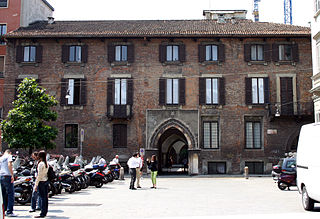
Palazzo Borromeo is a 13th-century building located at street #12 of Piazza Borromeo in Milan, region of Lombardy, Italy,. It stands across a small piazza from the church of Santa Maria Podone and a statue dedicated to the 16th-century archbishop and cardinal, St Charles Borromeo.

The Palazzo delle Scuole Palatine is a historic building of Milan, Italy, located in Piazza Mercanti, the former city centre in the Middle Ages. It served as the seat of the most prestigious higher school of medieval Milan. Many notable Milanese scholars of different ages studied or taught in these schools; Augustine of Hippo and Cesare Beccaria, among others, served as teachers in the Palatine. The current building dates back to 1644, when it replaced an older one, which had the same function and was destroyed by a fire.

Casa Campanini is an art nouveau building in Milan, Italy, located at 11, Via Bellini. It was completed between 1903 and 1906 by architect Alfredo Campanini, who later inhabited the building.

Castello Cova, also known as Palazzo Viviani Cova is a landmark Neo-Gothic style residential and business building located on Via Giosuè Carducci #36, in central Milan, region of Lombardy, Italy. It is located some 100 meters west of the Basilica of Sant'Ambrogio. The building was designed by architect Adolfo Coppedè. Adolfo's career is also noted for designing the Casa del Fascio in Signa, and he was never shy to indulge in the appropriation of former styles and symbols; this building notable for its height and accumulation of Gothic architecture motifs such as a merlionated tower, peaked and rusticated ground-floor arches, and mullion-windows. It sports numerous decorated balconies on the facade.

The Palazzo Brentani is a monumental Neoclassical palace, located on Via Manzoni #6, in the centre of Milan, region of Lombardy, Italy. Both this palace and the adjacent Palazzo Anguissola have sober academic facades, designed by Luigi Canonica in 1829.

Giuseppe Zanoia (1752–1817) was an Italian Neoclassical architect who is remembered for his Porta Nuova in Milan. He also collaborated on the Neogothic design of Milan's Duomo.

The Palazzo Anguissola or Anguissola Traversi is a palace located at Via Manzoni number 10, in central Milan, a city in the northern Italy. Construction began in 1778, and its Neoclassical facade, designed by Luigi Canonica, was added in 1829.

Palazzo Arese was a 16th century baroque palace and seat of a branch of the House of Arese in Milan, Italy. It was located adjacent to Casa Fontana Silvestri near the Porta Orientale. The palazzo was demolished in 1943 following damage sustained during the bombing of Milan in World War II.
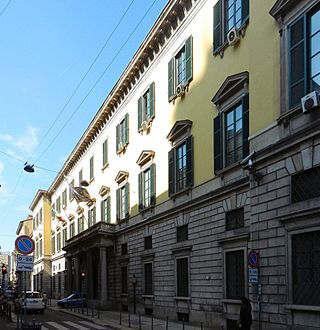
The Prefecture, Milan, also known as Palazzo Diotti, is a historic neoclassical building which has been the location of the office of the Prefect of Milan since 1859. The building is situated at 31, Corso Monforte in the city.

The Palazzo del Monte di Pietà is a 15th-century palazzo in Milan, Italy, adapted in a neoclassical style in the 18th century by Giuseppe Piermarini. Historically belonging to the Sestiere di Porta Nuova, it is located in Via Monte di Pietà no. 5, and was the seat of the Monte di Pietà di Milano.

The Palazzo di Prospero Visconti' is a 16th-century palace in Milan. Historically belonging to the sestiere di Porta Ticinese, it is located in via Lanzone 2, in the ancient contrada del Torchio no. 2,919.

Palazzo Isimbardi, also palazzo della Provincia, is a historic building in Milan located at 35 Corso Monforte, the seat of the Metropolitan City of Milan.
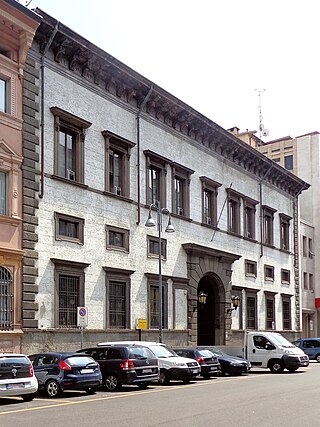
Palazzo Spinola is a 16th-century palazzo in Milan, heavily remodelled during the 19th century. Historically belonging to the sestiere di Porta Nuova, it is located at 10 Via San Paolo. Since 1808 it has been the seat of the Garden Society.
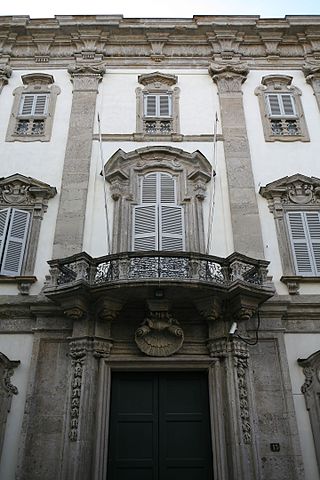
Palazzo Cusani is a 17th-century palace in Milano, remodelled a first time between 1712 and 1719 and a second time between 1775 and 1779. Historically belonging to the sestiere of Porta Nuova, it is located at via Brera 13–15.
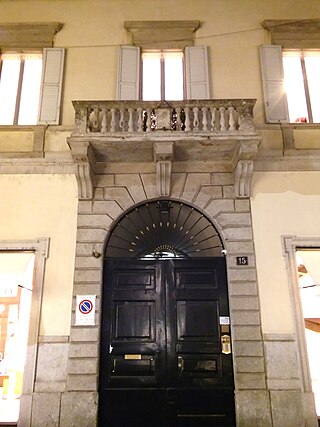
Casa Crespi is a historic building in Milan located at 15 Via Sant’Andrea.

Palazzo Acerbi is a 17th-century palace in Milan in the Baroque style. Historically belonging to the sestiere di Porta Romana, the palace is located at corso di Porta Romana no. 3.
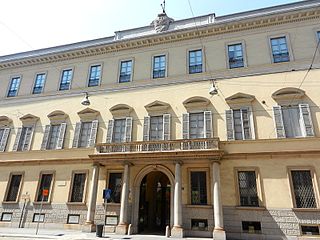
Palazzo Borromeo D’Adda, is an 18th-century palazzo in Milano. Historically belonging to the sestiere di Porta Nuova, it is located at via Manzoni no. 39/41.
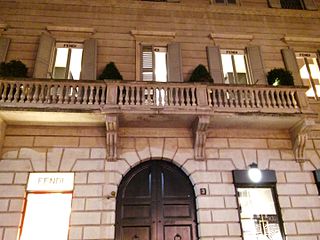
Palazzo Carcassola Grandi is a historical palace in Milan located at via Monte Napoleone 3.























